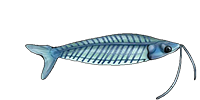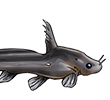would i be wrong if i were to say that the one on the left is a Panaque albomaculatus and the one on the right is a Panaque nigrolineatus .. if i am wrong please correct me and if you need more pictures just tell me what angles you need and you'll get them
what kind of royals are these?
what kind of royals are these?
here's the picture :

would i be wrong if i were to say that the one on the left is a Panaque albomaculatus and the one on the right is a Panaque nigrolineatus .. if i am wrong please correct me and if you need more pictures just tell me what angles you need and you'll get them
would i be wrong if i were to say that the one on the left is a Panaque albomaculatus and the one on the right is a Panaque nigrolineatus .. if i am wrong please correct me and if you need more pictures just tell me what angles you need and you'll get them
- Silurus
- Posts: 12460
- Joined: 31 Dec 2002, 11:35
- I've donated: $12.00!
- My articles: 55
- My images: 896
- My catfish: 1
- My cats species list: 90 (i:0, k:0)
- Spotted: 428
- Location 1: Singapore
- Location 2: Moderator Emeritus
- Dinyar
- Posts: 1286
- Joined: 31 Dec 2002, 00:34
- My articles: 3
- My images: 226
- My catfish: 10
- My cats species list: 3 (i:10, k:0)
- Spotted: 94
- Location 1: New York, NY, USA
- Interests: Mochokidae, Claroteidae, Bagridae, Malepteruridae, Chacidae, Heteropneustidae, Clariidae, Sisoridae, Loricariiadae
- Silurus
- Posts: 12460
- Joined: 31 Dec 2002, 11:35
- I've donated: $12.00!
- My articles: 55
- My images: 896
- My catfish: 1
- My cats species list: 90 (i:0, k:0)
- Spotted: 428
- Location 1: Singapore
- Location 2: Moderator Emeritus
- Jools
- Expert
- Posts: 16273
- Joined: 30 Dec 2002, 15:25
- My articles: 198
- My images: 941
- My catfish: 237
- My cats species list: 87 (i:13, k:1)
- My BLogs: 7 (i:10, p:167)
- My Wishlist: 23
- Spotted: 450
- Location 1: Middle Earth,
- Location 2: Scotland
- Interests: All things aquatic, Sci-Fi, photography and travel. Oh, and beer.
- Contact:
It's hard to say without seeing the fish in the "flesh", but I would say the fish on the right (in the dorsal view) is P. nigrolineatus from northern South Amercia and the other is not although it could be from far apart as Colombia or Brazil! The paleness is not a factor to use here. The orange fin tips and belly and leading fin ray patterning are (to a degree). Am I correct in saying the figh with the lines in the belly pattern is the one with the heavier orange edging?
Jools
Jools
Owner, AquaticRepublic.com, PlanetCatfish.com & ZebraPleco.com. Please consider donating towards this site's running costs.
- Dinyar
- Posts: 1286
- Joined: 31 Dec 2002, 00:34
- My articles: 3
- My images: 226
- My catfish: 10
- My cats species list: 3 (i:10, k:0)
- Spotted: 94
- Location 1: New York, NY, USA
- Interests: Mochokidae, Claroteidae, Bagridae, Malepteruridae, Chacidae, Heteropneustidae, Clariidae, Sisoridae, Loricariiadae
Caol_ila,
Just wondering regarding your last statement, you were referring to the photo with the spotted belly of LiSCN? How about this "L27a" that arrived in my country recently? The first half of the body, from the snout to the back and dorsal fin is striped, but from the dorsal or adipose fin to the tail it is spotted.
Right now this fish is around 2-2.5 inches. Do they start having these half body stripes when they are this size and grow to have the spots on the whole body or will they just stay this way until they grow bigger?
Just wondering regarding your last statement, you were referring to the photo with the spotted belly of LiSCN? How about this "L27a" that arrived in my country recently? The first half of the body, from the snout to the back and dorsal fin is striped, but from the dorsal or adipose fin to the tail it is spotted.
Right now this fish is around 2-2.5 inches. Do they start having these half body stripes when they are this size and grow to have the spots on the whole body or will they just stay this way until they grow bigger?
pics of the "L27a" that mokmu was describing
http://pictures.care2.com/view/2/370030746
http://pictures.care2.com/view/2/772780484
http://pictures.care2.com/view/2/370030746
http://pictures.care2.com/view/2/772780484
- Yann
- Posts: 3617
- Joined: 30 Dec 2002, 20:56
- I've donated: $20.00!
- My articles: 8
- My images: 275
- My cats species list: 81 (i:0, k:0)
- My BLogs: 2 (i:3, p:81)
- Spotted: 109
- Location 1: Switzerland
- Location 2: Switzerland
- Interests: Catfish mainly form South America, Cichlids, Geckos, Horses WWII airplanes, Orchids
-
Plec0maniac
- Posts: 326
- Joined: 08 Apr 2003, 10:46
- Location 1: Manila, Philippines
Itz possible that the upper photo is an L27a because when upside-down the patterns of the panaque seems to be spotted...  I guess this plec is just stressed thats why the color of the plec isnt that intense! The other one is definitely an L27 or L27c
I guess this plec is just stressed thats why the color of the plec isnt that intense! The other one is definitely an L27 or L27c
Too many gorgeous loricariids
So hard to obtain! Grrr....
So hard to obtain! Grrr....





